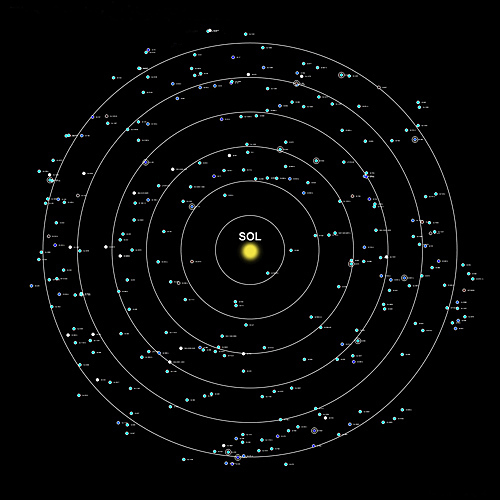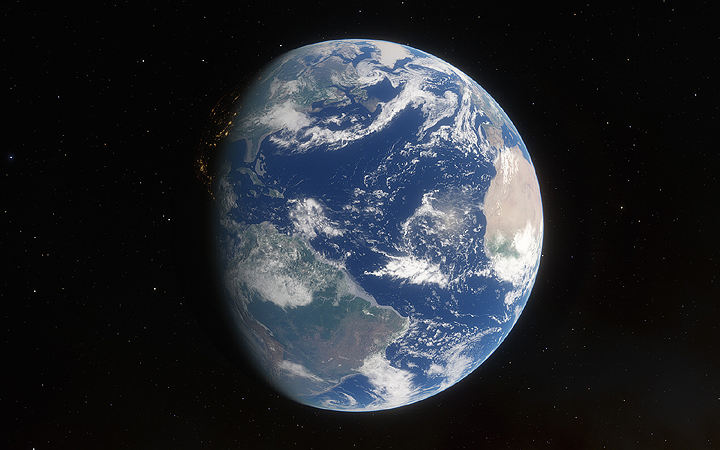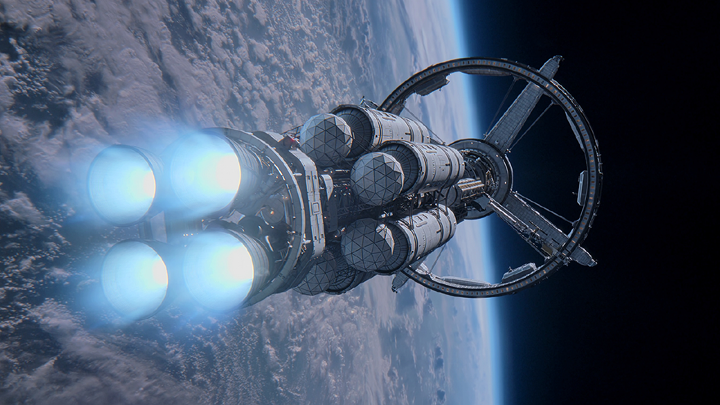
NEIGHBORING SYSTEMS: Alpha Centauri 4.3 lys Sirius 8.6 lys Epsilon Eridani 10.5 lys
SOL is a yellow-orange dwarf located in the outer spiral arm of Orion. Its circular orbit around the center of the Milky Way is only slightly inclined relative to the Galactic plane; preventing it from plunging into the galaxy’s core where lethal supernovae are more common. Fewer than five percent of all stars exhibit such a stable orbit which also includes many of the systems within the immediate stellar neighborhood. This star has a total of eight planets in orbit, as well as several planetoids, hundreds of moons, and a main asteroid belt located inside the inner regions of the system. It is also relatively rich in elements heavier than hydrogen such as iron, carbon, gold, and uranium.
EARTH is the third planet in this system and nearly 75 percent of its surface is covered by vast salt water oceans with numerous lakes and rivers as well. This world hosts a variety of different environments including temperate forests, tropical jungles, and arid deserts. It also one large moon, referred to as Luna, which helps to stabilize the planet’s axial tilt, thus contributing to a wide-range of seasonal variations.
Earth hosts a wide variety of both plant and animal life and also holds the distinction of being the homeworld of the Human race.

HUMANS originally evolved from a branch of early primates characterized by erect posture and bipedal locomotion. They are generally a very passionate species capable of exhibiting a wide range of intense emotions. Their characteristic need to understand and control the world around them has been the basis for their development of science, philosophy, and religion. Subsequently, they have established an assortment of governments and cultures; unifying people within a particular region and giving rise to countless regimes and empires. It should be noted that disagreements over conflicting belief systems have often led to devastating wars throughout Human history. Other races generally describe them as curious, innovative, arrogant, and opportunistic.

The rapid advancement in scientific and medical knowledge in the 19th and 20th centuries led to an overall improvement in their quality of life. However, the resulting over-industrialization and over-population of their homeworld has had a destructive impact on much of the environment.
By the late 21st century, global warming had caused a dramatic rise in sea levels, created extreme droughts and famines, and made the equatorial regions virtually uninhabitable. Widespread migrations of the world’s population from countries near the equator to more temperate regions necessitated the construction of megacities to provide housing for the nearly 15 billion inhabitants of Earth. Although there were still a small number of countries that initiated strict security measures at their borders, most of the industrialized world began to cooperate freely across national boundaries; trading provisions, technology, and resources, in addition to establishing a greater diversity of cultures and societies as well.

With nearly all of Earth’s fossil fuels depleted; solar, wind, and fusion technologies were used exclusively as sources of renewable energy. Yet even with these adaptations, most of the world leaders were well aware that, without greater quantities of desalinized water for hydroponics and irrigation, or a continual supply of nutrient-rich soil for farming, their homeworld would eventually become unsustainable for Human life. Several countries began turning to major corporations in the field of space technology to obtain new resources from throughout the Sol system. By the end of the 21st century, there were nearly a dozen commercial colonies on Luna and the planet Mars, various mining operations throughout the main asteroid belt, and even a few permanent outposts on Jupiter’s moons.
Meanwhile, a growing portion of the population was becoming increasingly frustrated over the amount of government spending off-world while billions of people on Earth continued to exist in poverty. A multi-national extremist organization identified as Earthborn was responsible for numerous acts of economic terrorism and even orchestrated the fall of China’s principal credit system. This single act caused a devastating ripple effect around the globe, bringing many countries to the verge of financial collapse.
Four years later, a group of prominent business leaders assembled together in Geneva to determine a solution to this ongoing crisis. These individuals, like much of the world’s population, had become convinced that the politicians and bureaucrats had failed them. After several months of deliberations, these investors unanimously signed a charter which instituted the United Earth Conglomerate (UEC) as a regulatory commission with nearly limitless authority over all commercial activities throughout the Sol system. Within 60 years, nearly a dozen major companies had established even more permanent colonies and outposts as far out as Saturn. As the UEC continued to gain further influence over the world economy, this organization began to devise changes to both financial and administrative policies; eventually taking on the role of a global corporate empire.

The utilization of Faster-Than-Light (FTL) propulsion engines made it possible for the Human race to establish permanent colonies in ten other star systems within 30 light years of Sol. Although this development led to the acquisition of a variety of new resources; greed and corruption permeated nearly every facet of the UEC and most of Earth’s population continued to live in destitution. Those who could find a means to do so often immigrated to these interstellar colonies with the hopes of a better life.
Yet, as Humans continued to spread themselves out among the stars, they soon discovered that they were not alone in the galaxy. First contact with the advanced race known as the Brekka was initially met with mixed reactions, but a compromise was eventually achieved based on the idea of mutual respect and the desire for peace. However, after a fateful encounter with the Zendathu, the Human race found itself in the middle of a devastating war. For seven long years, most of the UEC security forces built up a protective perimeter in close proximity to Earth, while relying on its outer colonies to act as the first line of defense against a relentless enemy.
After the war was over, many of the colonies felt a great deal of resentment toward Earth for essentially leaving them to fend for themselves. In addition, the Mining Guild began to impose further regulations and higher taxes on everything the colonists had worked so hard to accomplish. For decades, the UEC had managed to maintain direct authority over these distant worlds, but in only a few short years, most of the colonies had declared their independence and begun to establish their own individual governments.
By the beginning of the 23rd century, Earth’s corporate empire was reduced to only five star systems which included Sol, Epsilon Eridani, Epsilon Indi, Eta Cassiopeiae, and Delta Pavonis. The loss of the additional systems and their resources has greatly weakened the UEC both collectively and economically. Although several of the independent colonies work together on a regular basis as an interconnected community; their relationship with Earth continues to remain tense.
In recent years, the UEC has implemented a free trade agreement with the independent systems in an effort to promote mutual cooperation between them. Nevertheless, Earth’s government has gradually become more of a military state; even sending its security forces as escorts on trade missions to the other colonies. Many see this as a blatant attempt on the part of the UEC to maintain a pretense of superiority over these autonomous systems which no longer need their support.